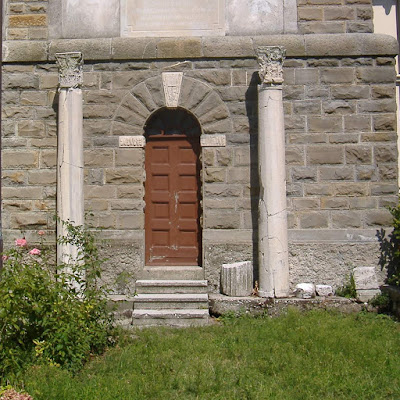The Adriatic Sea takes it’s name from the city of Adria which was founded circa 800 BC and established as a port on the sea around 500 BC (source; Romolo A. Staccioli "Gli Etruschi un popolo tar mito e realta'"). What was then the name of this sea for Homer and Hesiod whom were writing in 900 BC, a period previous to the founding of Adria. I believe that Homer when speaking of the Atlantic Ocean is actually referring to the Adriatic Sea. If there were truly an advanced civilization at war with Greece as described in Timaeus by Critias it was probably mentioned by Homer in the Odyssey when Odysseus made his journey in the Mediterranean. I suggest to the readers of this blog to read not only Plato's Timaeus and in particular when Critias introduces Atlantis and later on where he describes Atlantis in detail but also to re-read The Odyssey.
In Timaeus there's an interesting description that the Egyptian priests made of the Atlantic Ocean to Solon (600 BC);
"…starting from a distant point in the Atlantic Ocean, was insolently advancing to attack the whole of Europe, and Asia to boot. For the ocean there was at that time navigable; for in front of the mouth which you Greeks call, as you say, 'the pillars of Heracles, there lay an island which was larger than Libya and Asia together; and it was possible for the travelers of that time to cross from it to the other islands, and from the islands to the whole of the continent over against them which encompasses that veritable ocean. For all that we have here, lying within the mouth of which we speak, is evidently a haven having a narrow entrance; but that yonder is a real ocean, and the land surrounding it may most rightly be called, in the fullest and truest sense, a continent. Now in this island of Atlantis there existed a confederation of kings…"
Plato "Timæus"
The description is somewhat confusing, but apparently the Atlantic Ocean that the Egyptian priest is talking about was surrounded by a continent and the island of Atlantis has given it’s name to the sea in front of it. My interpretation is that the Atlantic Ocean is the Adriatic Sea not only for Plato (420 BC) and Solon (600 BC), but especially for Homer (900 BC). When reading The Odyssey it is interesting to note that it is possible to follow the journey of Odysseus in the Aegean sea because the islands and places mentioned are real, such as Ithaca, Pylos, Samos, Zakynthos, and Dulichium, but at some point in the journey of Odysseus he deviates due to the wrath of Poseidon into the Atlantic Ocean where Ulysses shipwrecks and meets the Pheacians who will help him return to their land. There are many similarities between Plato's Atlantis and the story of the Pheacians of Homer and I'm going to list them in the next post. It seems strange that the Adriatic Sea was completely ignored by the Greeks and the Atlantic Ocean was often mentioned even though the Adriatic sea is much closer. I think it is reasonable to ask whether Homer in 900 BC was even aware of the existence of the Atlantic Ocean or if it is more plausible that it was simply the name he had for what is actually the Adriatic Sea. If my theory is correct the Adriatic Sea was known as the “Atlantic Ocean” to the ancient Greeks based on its proximity to Atlantis which I believe was located in North East Italy.
Translated from Italian by L. Morrongiello
Translated from Italian by L. Morrongiello










